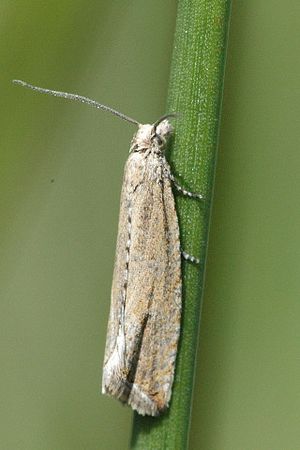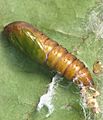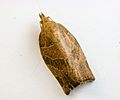Tortricidae facts for kids
Quick facts for kids Tortricidae |
|
|---|---|
 |
|
| Bactra lancealana | |
| Scientific classification |
|
| Kingdom: | Animalia |
| Phylum: | Arthropoda |
| Class: | Insecta |
| Order: | Lepidoptera |
| Clade: | Eulepidoptera |
| Clade: | Ditrysia |
| Section: | Cossina |
| Subsection: | Cossina |
| Superfamily: | Tortricoidea Latreille, 1803 |
| Family: | Tortricidae Latreille, 1803 |
| Subfamilies & Tribes | |
See also Taxonomy of Tortricidae for full list of genera. |
|
| Diversity | |
| Over 1,050 genera Over 10,350 species |
|
| Synonyms | |
|
Olethreutidae |
|
The Tortricidae are a large family of moths. They are often called tortrix moths or leafroller moths. These moths belong to the group of insects known as Lepidoptera, which includes all moths and butterflies.
There are over 11,000 different kinds, or species, of tortrix moths known around the world. They are the only family in a bigger group called the Tortricoidea. Many of these moths are important because they can cause problems for crops and plants. When these moths rest, their wings fold back, making them look rounded.
Some well-known tortrix moths are the codling moth and the spruce budworm. Scientists study these moths a lot because they can affect farming and forests.
Contents
What Do Tortrix Moths Look Like?
Tortrix moths are usually small. Their wingspan, which is the distance from one wingtip to the other, is typically 3 cm or less. Many species have dull colors like brown, with mottled or marbled patterns. This helps them blend in with their surroundings.
However, some tortrix moths are active during the day and have bright colors. They might even look like other moth families, such as Geometridae or Pyralidae.
Life Cycle and Habits
The eggs of tortrix moths are often flat and look like tiny scales.
The young moths, called larvae (or caterpillars), have different eating habits depending on their group.
- Larvae in the Chlidanotinae and Olethreutinae groups usually feed by boring into parts of plants. This means they tunnel into stems, roots, buds, or seeds.
- Larvae in the Tortricinae group, however, feed on the outside of plants. They are famous for making "leaf rolls." They do this by rolling up a leaf and living inside it for protection while they eat.
The Tortricinae larvae tend to eat a wider variety of plants than the other groups. They also have a special fork-like part at their rear end. They use this to flick their waste far away from their shelters, keeping their homes clean!
Common Tortrix Moths
Many tortrix moths are known as pests because they can damage important crops and trees. Here are some examples:
- Summer fruit tortrix moth (Adoxophyes orana)
- Fruit tree tortrix moth (Archips podana)
- Rose leaf roller (Archips rosana)
- Argyrotaenia ljungiana, which can be a pest on grapevines, corn, and fruit trees
- Peach moth (Cydia molesta)
- Codling moth (Cydia pomonella)
- Plum fruit moth (Cydia funebrana)
- Pea moth (Cydia nigricana)
- Chestnut and acorn moth (Cydia splendana)
- Light brown apple moth (Epiphyas postvittana)
- Hemp borer (Grapholita delineana)
- Oriental fruit moth (Grapholita molesta)
- Cherry fruitworm (Grapholita packardi)
- European grapevine moth (Lobesia botrana)
- Barred fruit tree tortrix moth (Pandemis cerasana)
- Grape berry moth (Paralobesia viteana)
- Long-palped tortrix (vine leaf roller) (Sparganothis pilleriana)
- Bud moth (Spilonota ocellana)
- False codling moth (Thaumatotibia (Cryptophlebia) leucotreta)
- Spruce budworm (Genus Choristoneura)
You might also be interested in the Mexican jumping bean moth (Cydia saltitans). Its larvae live inside jumping beans!
The Codling Moth: A Well-Known Example
The Tortricidae family is very important when it comes to insects that feed on apples. They are the most common group of insects found on apple trees, affecting the fruit, buds, leaves, and shoots. In New York, for example, at least seventeen different species of tortrix moths cause problems for apple farmers.
The codling moth (Cydia pomonella) is famous for causing "worm-holes" in apples. This moth originally came from Europe but has accidentally spread around the world. Now, it can be found wherever apples are grown, including North and South America, South Africa, Australia, and New Zealand.
Controlling these moths has been a big challenge for farmers. In the past, very strong chemicals like lead arsenate and DDT were used. However, these chemicals were dangerous for the environment, and the moths slowly became resistant to them. Today, farmers often use organophosphate sprays. They carefully time these sprays to hit the newly hatched larvae before they can bore into the fruit.
Gallery
See also
 In Spanish: Tortrícidos para niños
In Spanish: Tortrícidos para niños







